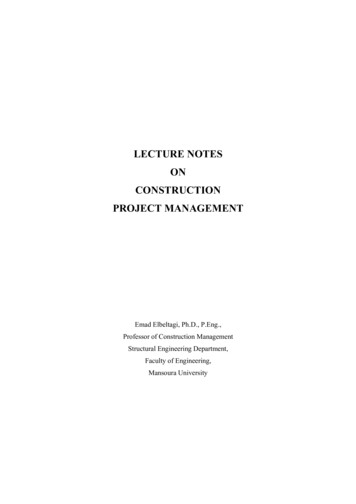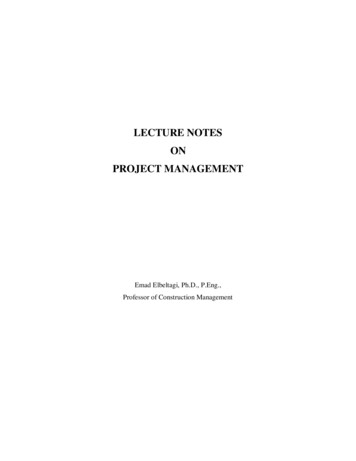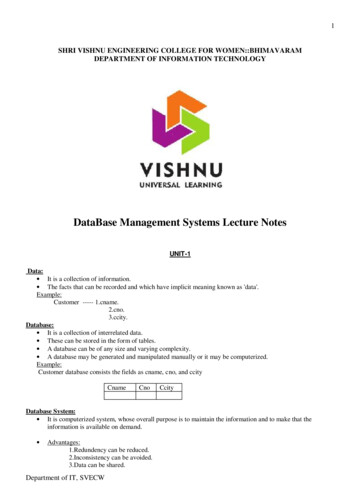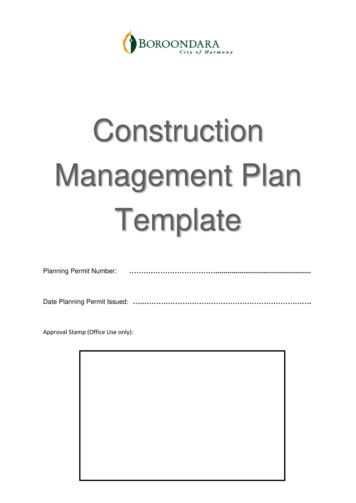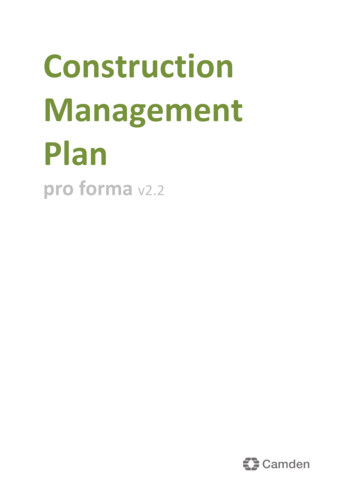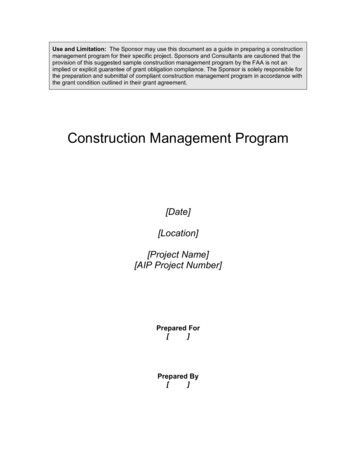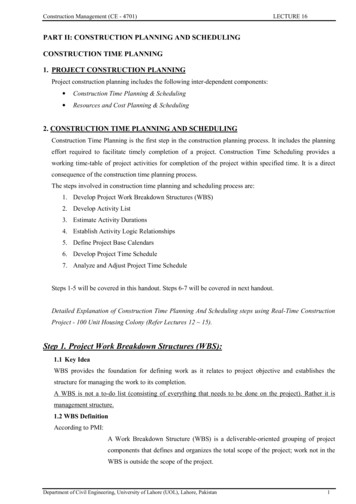
Transcription
Construction Management (CE - 4701)LECTURE 16PART II: CONSTRUCTION PLANNING AND SCHEDULINGCONSTRUCTION TIME PLANNING1. PROJECT CONSTRUCTION PLANNINGProject construction planning includes the following inter-dependent components: Construction Time Planning & Scheduling Resources and Cost Planning & Scheduling2. CONSTRUCTION TIME PLANNING AND SCHEDULINGConstruction Time Planning is the first step in the construction planning process. It includes the planningeffort required to facilitate timely completion of a project. Construction Time Scheduling provides aworking time-table of project activities for completion of the project within specified time. It is a directconsequence of the construction time planning process.The steps involved in construction time planning and scheduling process are:1. Develop Project Work Breakdown Structures (WBS)2. Develop Activity List3. Estimate Activity Durations4. Establish Activity Logic Relationships5. Define Project Base Calendars6. Develop Project Time Schedule7. Analyze and Adjust Project Time ScheduleSteps 1-5 will be covered in this handout. Steps 6-7 will be covered in next handout.Detailed Explanation of Construction Time Planning And Scheduling steps using Real-Time ConstructionProject - 100 Unit Housing Colony (Refer Lectures 12 15).Step 1. Project Work Breakdown Structures (WBS):1.1 Key IdeaWBS provides the foundation for defining work as it relates to project objective and establishes thestructure for managing the work to its completion.A WBS is not a to-do list (consisting of everything that needs to be done on the project). Rather it ismanagement structure.1.2 WBS DefinitionAccording to PMI:A Work Breakdown Structure (WBS) is a deliverable-oriented grouping of projectcomponents that defines and organizes the total scope of the project; work not in theWBS is outside the scope of the project.Department of Civil Engineering, University of Lahore (UOL), Lahore, Pakistan1
Construction Management (CE - 4701)LECTURE 16Stated in another way, a WBS is the hierarchy of work you must accomplish to complete a project. TheWBS is structured in levels of work detail, beginning with the end result or product, and then divided intoidentifiable work elements. Each descending level in a WBS represents an increasingly detaileddescription of the project deliverables.These definitions imply that a WBS has the following characteristics:1. It is representative of work, and this work has a tangible result.2. It is arranged in a hierarchical structure.3. It provides a management structure.1.3. WBS LevelsThe WBS will include all work to be done by the primary organization. While generally the WBSconsists of a five-level hierarchy describing the entire effort to be accomplished by the primaryorganization, that number may not be appropriate for all situations. The depth of a WBS is dependentupon the size and complexity of the project and the level of detail needed to plan and manage it.The WBS levels may be broadly categorized into five major levels. These levels, arranged in adescending hierarchical order are:Level 1: Program levelLevel 2: Project levelLevel 3: Task levelLevel 4: Sub-Task LevelLevel 5: Work Package levelA WBS is normally presented in chart form (see Fig. 1).Fig. 1. Hierarchical Chart for WBSDepartment of Civil Engineering, University of Lahore (UOL), Lahore, Pakistan2
Construction Management (CE - 4701)LECTURE 16The upper three levels of the WBS are normally specified by the client (as part of an RFP - Request ForProposal) as the summary levels for reporting purposes. The lower levels are generated by the Contractorfor in-house control.Fig. 2. Project Control and WBS Levels1.3.1. Program and Project Levels:Program level defines the overall work program. A work program consists of two or more inter-relatedprojects with overall time, cost and performance objectives and resource constraints. Each group of majorworks which can progress in a systematic manner, with minimal interference from other works, andwhich produces a major deliverable can be treated as a project. Each project is assigned time, cost andperformance objectives and is provided with planned resources for accomplishing the project objectives.In the 100 Housing Units Residential Colony Project, each category of construction (Categories A to D)can be treated as a project (see Exhibit 2) while the whole work can be treated as a program.The number of projects in a program varies with the nature and complexity of the program. Note thateach project may comprise of one or more contract packages.1.3.2. Task and Sub-Task Levels: A task represents a higher level significant work output within aproject (for example, feasibility report which marks phase end deliverable for the feasibility phase of aproject). Each task can further be decomposed in sub-tasks (for example, EIA study report, benefit-costanalysis report, etc). This hierarchical structure of task / sub-tasks establishes a management structurewith desired level of management control at each level of project work.1.3.3. Work Package Level:According to PMI:"A Work Package is defined as a deliverable at the lowest level of the work breakdown structure, whenthat deliverable may be assigned to another (work) manager to plan, execute and control." This may beaccomplished by further decomposing each work package into activities.There is an important difference in the last work breakdown structure level and an activity. Typically, awork package includes the outcomes of more than one activity from more than one department/ area ofwork. Therefore, the work package does not have duration of its own and does not consume resourcesand cost directly; the resources and cost for the work package are simply the summation of the resourcesand costs for all the activities constituting the work package.Department of Civil Engineering, University of Lahore (UOL), Lahore, Pakistan3
Construction Management (CE - 4701)LECTURE 16Note that the lowest element of a WBS is a work package, which represents the lowest managementresponsibility level desired on the project, which in turn represents the level of trust in the managementteam.Exhibit 1 shows a simplified WBS for the housing colony project.1.4. Uses and Effectiveness of WBS1. Represents complete scope of work in an organized manner.2. Sorts work in a hierarchical order.3. Identifies major deliverables and sub-deliverables.4. Develops a list of work packages.5. Thought process tool. WBS helps the PM and the project team visualize exactly how the workof the project can be defined and managed effectively.Alternative ways of decomposing the work will be considered until an alternative is found withwhich the PM is comfortable.6. Strategy Design tool. WBS is a picture of the work of the project and how the items of work arerelated to one another.7. Management database at various Levels.8. Structuring of work organization. While WBS is developed, organizations, organizationalunits, teams and individuals are assigned responsibility for accomplishment of work components.9. Integration tool. WBS supports integrating responsibility for the various works with variousresponsibility units (organizations, departments, teams, individuals) by having a directrelationship between the WBS elements related to the Organizational Breakdown Structure(OBS) identified through the Responsibility Assignment Matrix (RAM).10. Work Budgeting. WBS can be used for budget allocation on individual work components. Usingthe project roll-up approach, this budget allocation can be consolidated into establishing theoverall project budget requirement.11. Planning tool. Using the lowest work package level of the WBS, time, resource and costrequirements of constituting activities are estimated; a work schedule is prepared; and deliverabledates and project completion are estimated.12. Monitoring and Reporting tool. Use of structure provides the opportunity to "roll up" (sum) thebudget and actual costs of the smaller work items into larger work elements so that performancecan be measured by organizational units and work accomplishment. These performancemeasurements can then be reported to senior management at various levels in the projectorganization.13. Communication tool. WBS defines communication channels and assists in understanding andcoordinating many parts of the project. The structure shows the work and organizational unitsresponsible and suggests where written communication should be directed. Problems can bequickly addressed and coordinated because the structure integrates work and responsibility.Department of Civil Engineering, University of Lahore (UOL), Lahore, Pakistan4
Construction Management (CE - 4701)LECTURE 161.5. WBS Development ProcedureProject WBS development is based on a technique called decomposition. Decomposition involvessubdividing work into smaller, more manageable components arranged in a hierarchical order until thework is defined in sufficient detail to facilitate management control as well as development of projectactivities. WBS development involves the following major steps:Step 1: Identify the projects in the program, if any. The projects should be defined in terms ofindependent major physical products of the program.Step 2: Identify the major deliverables of each project. The major deliverables should always be definedin terms of how the project will actually be organized and managed. There are two approaches to beconsidered: noun-type approaches and verb-type approaches.Noun-type approaches define the deliverable of the project work in terms of the physicalcomponents that make up the deliverable.For example: the physical units (areas - A1, A2, A3; sections - M1, M2, M3; building blocks Admin, CED, MED, Library)Verb-type approaches define the deliverable of the project work in terms of the actions that mustbe done to produce the deliverable.For example: the phases of the project life cycle (design, procurement, construction, handover), orthe work specialty (civil, mechanical, HVAC, etc.).Step 3: Decompose major deliverables to a level of detail appropriate for management and integratedcontrol. Decide if adequate cost and duration estimates can be developed at this level of detail for eachdeliverable. For each deliverable, proceed to step 5 if there is adequate detail, to step 4, if not – thismeans that different deliverables may have different levels of decomposition.Step 4: Identify constituent components of each deliverable (these are the subdeliverables or sub-tasks).As with deliverables, sub-deliverables should be described in terms of tangible, verifiable results tofacilitate performance measurement. Divide until criteria in step 3 is achieved. Now you are atworkpackage level.Every effort should be made to develop a WBS that is output-oriented in order to concentrate on concretedeliverables. If a WBS follows the organizational structure, the focus will be on the organization functionand processes rather than the project output or deliverables.Department of Civil Engineering, University of Lahore (UOL), Lahore, Pakistan5
Construction Management (CE - 4701)LECTURE 161.6. WBS for the 100 Housing Unit Residential Colony ProjectExhibit 1 shows a sample WBS for the 100 Housing Unit Residential Colony Project. Note that this is notthe only way to organize a WBS on this type of project. (what other ways are possible?).Exercise 1: The WBS in Exhibit 1 is not completely decomposed. After going through the next section(Activity List), refer back to this WBS and develop the missing levels.Exhibit 1. Work Breakdown Structure for Housing Colony ProjectStep 2. Develop Activity List:2.1 ActivityAn activity is an identifiable and measurable short duration task that has a definite start and stop point,consumes resources and represents cost.Each activity is a control point. An Activity Manager is responsible for seeing that the activity iscompleted on time, within budget and according to technical specifications.The resources and cost for a work package are simply the summation of the resources and costs for allthe activities constituting the work package. Thus, the activity is the basic unit used for planning,monitoring and controlling the project.Department of Civil Engineering, University of Lahore (UOL), Lahore, Pakistan6
Construction Management (CE - 4701)LECTURE 162.2. Activity DefinitionActivity definition involves identifying and documenting the specific activities that must beperformed in order to produce the work packages identified in the work breakdown structure.2.2.1. Inputs to Activity Definition Work breakdown structure. Identification of work elements Historical information. What activities were actually required on previous, similar projects Constraints. Factors that will limit the project team's work options. These constraints mayinclude: national economic policies, land reclamation constraints, unavailability implementingconstructionmethodologies. Assumptions. Factors that, for planning purposes, will be considered to be true, real, orcertain.2.2.2. Technique for Activity Definition Decomposition of WBS work packages.2.2.3. Output from Activity Definition Activity list. The activity list must include all activities that will be performed on the project.A well prepared activity list allows the project team to separate out all activities of each trade,as well as identify the activity types (see section 2.3).A sample activity list developed for a Category D house (single storey normal finish house) ofthe residential colony project is shown in Exhibit 2. Supporting Details. Supporting details for the activity list should include documentation of allidentified assumptions and constraints. For instance, if during excavation water tends to comeout then it should be clearly mentioned as to whether or not the pumping of water is includedwithin the scope of the project.Exercise 2: The Activit
PROJECT CONSTRUCTION PLANNING Project construction planning includes the following inter-dependent components: . Construction Management (CE - 4701) LECTURE 16 Department of Civil Engineering, University of Lahore (UOL), Lahore, Pakistan 2 Stated in another way, a WBS is the hierarchy of work you must accomplish to complete a project. The .
